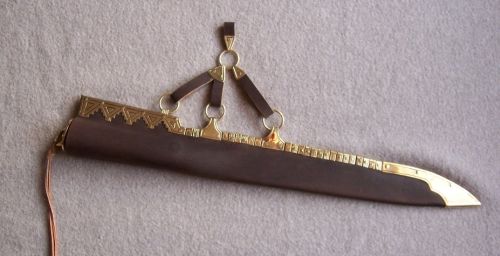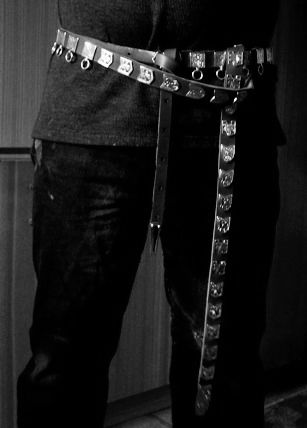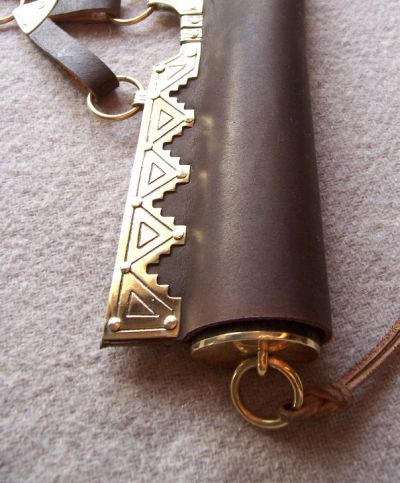Posts: 16 Location: United Kingdom
Mon 26 Mar, 2007 11:16 am
"Gotland"style battle knife
Posts: 2,698 Location: Indonesia
Tue 27 Mar, 2007 9:45 am
Great knife--though I would have preferred a rather rougher finish on the blade...
Posts: 38 Location: maryland
Tue 27 Mar, 2007 10:03 am
Whoo pretty...
does the hilt go into the sheath..? That interesting... lol sorry i dont know much about early russian warfare, it'd be nice if you post some more topics on russian warriors, I would be much more enlightened. =D
Posts: 142 Location: Uppsala
Tue 27 Mar, 2007 4:00 pm
Sweden is full of
seaxes with this type of sheaths. There are findings from gotland, Birka, valsgärde and Vendel.
This type of weapon is found in swedish graves from late migration era to early viking age. I am no expert but I would say that this type of seax is not russian but swedish, and mainly from the areas around lake mälaren.
It is a beautiful knife, and the reconstruction looks great.
Posts: 620 Location: Bjästa, Sweden
Tue 27 Mar, 2007 4:10 pm
| Ville Vinje wrote: |
Sweden is full of seaxes with this type of sheaths. There are findings from gotland, Birka, valsgärde and Vendel.
This type of weapon is found in swedish graves from late migration era to early viking age. I am no expert but I would say that this type of seax is not russian but swedish, and mainly from the areas around lake mälaren.
It is a beautiful knife, and the reconstruction looks great. |
Accutally it´s wider spread than that and has been around in nothern Europe sence around 200 BC! In slightly different styles and areas but it is basiclly the same "family" of weapons.
Very nice reconstruction!
Posts: 291 Location: NW Ark
Tue 27 Mar, 2007 6:24 pm
| Lafayette C Curtis wrote: |
| Great knife--though I would have preferred a rather rougher finish on the blade... |
how much rougher????
just curious (and off topic completely)
Posts: 53 Location: Poland
Tue 27 Mar, 2007 10:12 pm
"Sweden is full of
seaxes with this type of sheaths"
well, that's not surprise, waregs (wariagi) are just norsmens, word "Russia" "Ross" "Rus" have, in my opinion, a Swedish (or other norman) origin.
Posts: 16 Location: United Kingdom
Wed 28 Mar, 2007 12:39 am
Thank you guys for your kind answers:-) Knifes of this type was quite popular in eastern parts of Europe and Scandinavia as well. For me it was like a second weapon after sword ,which is always with you. We have like 10-20 famous examples from Birka, Gotland or Gnezdovo they looks a little bit diffrent but its still the same style so very characteristic for Russ ( Swedish )Traders and Warriors. Right now my blade is made just from hand forged steel but in the future ( I hope) it will be damascus. My regards and best wishes for "Sverige" and "East" team :-)
Posts: 246
Wed 28 Mar, 2007 3:37 am
Very Nice!
I think that style of knife/sheath was popular all around the Baltic, Gotland being one place where they where quite prolific.
I have never seen any Norman, Danish or Norwegian examples?
The belt is either a traded or copied style of the nomadic military rank belt. Probably Hungarian or khazar.
Cheers
Nick
Posts: 246
Wed 28 Mar, 2007 3:41 am
Yes here they are? I cant see yours to clearly but I think this is the original belt.
 Attachment: 57.61 KB
Attachment: 57.61 KB
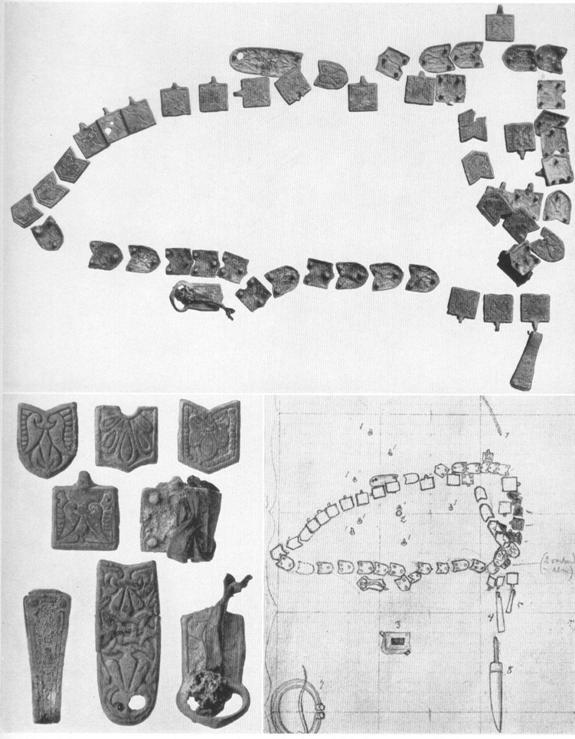
Posts: 2,698 Location: Indonesia
Wed 28 Mar, 2007 8:37 am
| John Cooksey wrote: |
how much rougher????
just curious (and off topic completely) |
I'm not sure whether the image at the base of the blade is taht of a metal fitting or a reflection of Ladoga taking pictures of his own knife. If the latter, then I have to say that I don't like that level of mirror polish because it's a bit hard to maintain and doesn't really look "macho" to my eyes. It's way too shiny.
Other than that, though, it looks like a great knife.
Posts: 16 Location: United Kingdom
Wed 28 Mar, 2007 10:19 am
Nick my belt was based on B716 :-) which was found in Birka. So bulls eye:-) It was Khazarian more than Hungarian ( its slightly different than magyar examples different kind of flowers and plants:-) )
Posts: 53 Location: Poland
Wed 28 Mar, 2007 1:24 pm
Are you sure there was any of this knifes make of damascent steel?
I mean real damast, not a jiver. You probably will have some problem with real damast (wootz is out of market for about 200 ears :) ) but if you buy this knife in Poland, you will be interested with this link
http://www.allegro.pl/item168093437_dzambia_d..._1_zl.html
(can I place this link? it's auction, but long time ower)
this auction is ower, but I think guy produces this blades, - there was other blades from this man, with same fantastic pattern, but modern shape
Posts: 53 Location: Poland
Wed 28 Mar, 2007 1:38 pm
I just take a look on a Torkil's site.
Are you shure you want "damast"? He makes wonderful acided (kislotrafaret? kak shelkotrafaret) designs.
Posts: 16 Location: United Kingdom
Wed 28 Mar, 2007 3:00 pm
Kerim ofcourse "jiver" but I am not sure if all people understand the difference between ( but "Damast" its more easy to understand) :-) Jiver is typical for early medieval Europe . Damast need special kind of steel (different material) so in my opinion its unbelievable to make this kind of blade in Europe in now days
Last edited by Ladoga S on Wed 28 Mar, 2007 3:23 pm; edited 2 times in total
Posts: 16 Location: United Kingdom
Wed 28 Mar, 2007 3:08 pm
Acided????? hmmmm please can you explain. Like I mention before my blade was made by someone different(Bert) not by Thorkil. And my apologise i should call that kind of steel pattern welded :-(
Last edited by Ladoga S on Wed 28 Mar, 2007 3:21 pm; edited 1 time in total
Posts: 98 Location: Poland
Wed 28 Mar, 2007 3:09 pm
| Kerim Mamedov wrote: |
I just take a look on a Torkil's site.
Are you shure you want "damast"? He makes wonderful acided (kislotrafaret? kak shelkotrafaret) designs. |
Kerim, I really don't understand you. You are from Poland, so why you can't see that is it written on my side that pattern welded blades aren't made by me. Some are bought in England and some are made by my friend : Robert Kapusta. But those made by Bert aren't yet on side. They will be available to see soon. So, please, don't misguide people, OK? ;) I never appropriate other people's work and hate when others do this.
EDIT: Ladoga, not my production are only pattern welded blades and scramasax blade. The rest is made by me. ;)
Posts: 620 Location: Bjästa, Sweden
Wed 28 Mar, 2007 3:14 pm
| Nick Trueman wrote: |
Very Nice!
I think that style of knife/sheath was popular all around the Baltic, Gotland being one place where they where quite prolific.
I have never seen any Norman, Danish or Norwegian examples?
The belt is either a traded or copied style of the nomadic military rank belt. Probably Hungarian or khazar.
Cheers
Nick |
There is a few early ones from Denmark and Nothern Germany.
 Attachment: 98.94 KB
Attachment: 98.94 KB
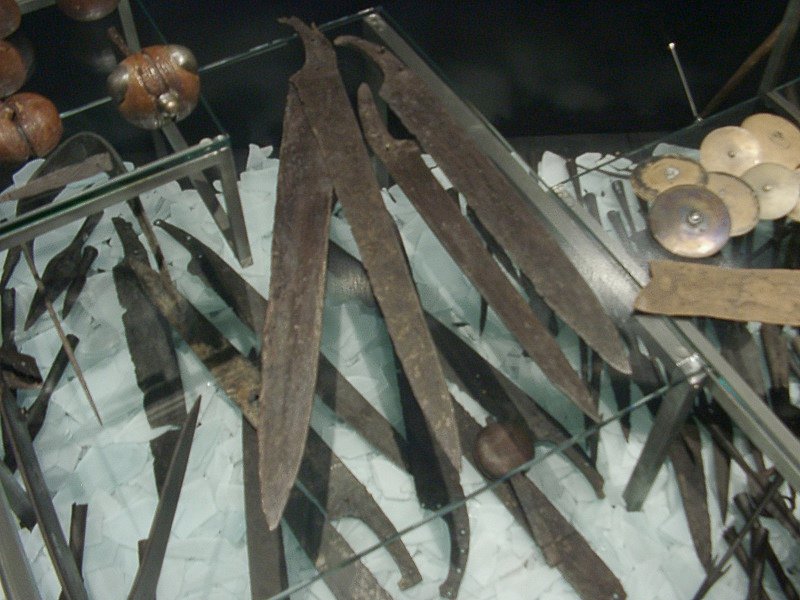
Seaxes
Posts: 53 Location: Poland
Wed 28 Mar, 2007 5:17 pm
Well Grzesiu (jeśli można :) ) all what I was saying, that for this kind of knife drawings fit more than jiver, IMHO.
I noticed that some of a blades are made by other peoples from other countries, it shows that you work with a best people all over Europe, but for me as a "consument" they still are "Torkiel's blades" - they are on your site, and I'm just a consument and think in specific way :)
But let's return to the point - the question is - what kind of a blade will be more fiting for this design: damast/jiver or patern with slovian/skandinavian drawing?
My point is to drawing. (hoever makes it)
And BTW, Torkiel, in polish wersion of a site it's more info about knifes.
Posts: 53 Location: Poland
Wed 28 Mar, 2007 5:24 pm
Acided????? hmmmm please can you explain....
You say that next one will be damast, so I understand that you are going to buy next knife?
And next one will be damast blade. right?
So, I take a look on a side, and find that there are great skandinawian drawings on some blades, made using acid
(I don't now how it will be in english, only in Polish or Rusian)
It seems to me, that that wariag knife will look beter with drawings on a blde,
rather than damast blade without any pattern.
You
cannot post new topics in this forum
You
cannot reply to topics in this forum
You
cannot edit your posts in this forum
You
cannot delete your posts in this forum
You
cannot vote in polls in this forum
You
cannot attach files in this forum
You
can download files in this forum


